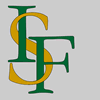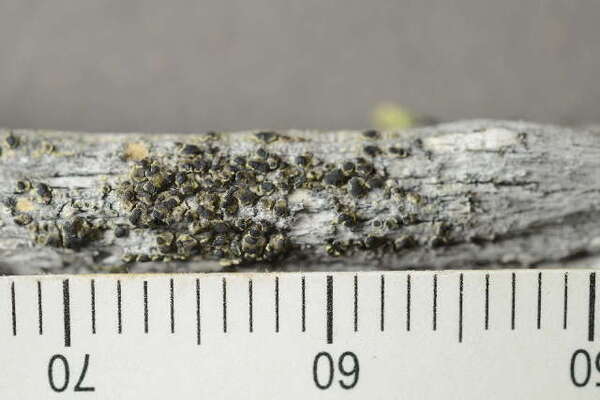Palicella filamentosa (Stirt.) Rodr. Flakus & Printzen
Lichenologist, 46: 540, 2014. Basionym: Lecidea filamentosa Stirt. - Scott. Natural., 5: 218, 1879
Synonyms: Lecanora filamentosa (Stirt.) Elix & Palice; Lecanora ramulicola (H. Magn.) Printzen & P.F. May; Lecidea dalecarlica Hedl.; Lecidea hercynica M. Hauck & Schmull; Lecidea ramulicola (H. Magn.) Hillm. non H. Magn. (1952) nec H. Magn. (1953); Lecidea saepincola Ach. var. ramulicola H. Magn.
Distribution:
Description: Thallus crustose, whitish, episubstratic and 0.1-0.4(-0.7) mm thick, rimose-areolate to strongly warted, the warts 0.1-0.2(–0.4) mm wide, rarely endosubstratic and poorly evident, sometimes delimited by a white prothallus. Pseudocortex of gelatinized, 2.5-3 μm thick, branched and anastomosing, semi-anticlinally arranged hyphae; medulla compact, of highly branched, entangled, 2.5–3 μm thick hyphae, I-. Apothecia sometimes cryptolecanorine when young, but usually appearing biatorine, rounded to irregular in outline, frequently crowded and coalescing, adnate to sessile, 0.3-0.6(-0.9) mm across, with a cream-coloured, red-brown to brown-black, flat to convex, sometimes faintly pruinose disc, a concolorous to slightly paler, thin, hardly raised, finally often excluded proper margin, and (in young apothecia only) an ephemeral thalline margin. Proper exciple yellow-brown to orange brown in outer part, colourless within, 30-55 μm wide laterally, 30-90 μm wide at base, of strongly gelatinized, branched and anastomosing, radiating hyphae with strongly elongate lumina; epithecium yellow brown to orange-brown, with a layer of coarse granules which sometimes streak into the hymenium, dissolving in K but not in N, the Cinereorufa-green pigment and a brown pigment reacting K+ greenish brown or greyish brown; hymenium colourless, (35-)40-70 μm high, I+ blue; paraphyses lax in K, moderately branched and anastomosing, 1.2-2 μm thick, the apical cells not markedly wider; hypothecium colourless to pale yellow, 15-90(-150)
μm high, I+ weakly blue. Asci 8-spored, the tholus I+ blue, with a wide axial body that is mostly surrounded by a distinct darker staining layer (Lecanora/Lecidella-type). Ascospores 1-celled (rarely a few 1-septate), hyaline, narrowly ellipsoid, (10-)12.5-13.5(-16) x (3.5-)4-4.5(-5) μm. Pycnidia rare, black, immersed, the conidiogenous cells flask-shaped with long to very long necks, apparently terminal. Conidia thread-like, (9-)11-15(-17) x c. 1 μm. Photobiont chlorococcoid. Spot tests: thallus K+ yellow, C-, KC-, P+ yellow. Chemistry: thallus with atranorin and traces of usnic acid; apothecia with paraensic acids C, D, G and the Cinereorufa-green pigment.Note: a mainly boreal-montane, very variable species found on wood, but also on acid bark in humid, montane coniferous forests. Widespread in northern and central Europe, and known from a few stations in the Eastern Alps (Austria, Switzerland), where it is probably more widespread, the distribution being poorly known due to frequent misidentifications, especially with Lecanora symmicta and similar species. To be looked for in the Italian Alps. For further details see Printzen & May (2002), Pérez-Ortega & Printzen (2007), Palice & al. (2011), Dietrich & al. (2020).
Growth form: Crustose
Substrata: bark and lignum
Photobiont: green algae other than Trentepohlia
Reproductive strategy: mainly sexual
Most common in areas with a humid-warm climate (e.g. most of Tyrrenian Italy)

Predictive model
Growth form: Crustose
Substrata: bark and lignum
Photobiont: green algae other than Trentepohlia
Reproductive strategy: mainly sexual
Most common in areas with a humid-warm climate (e.g. most of Tyrrenian Italy)

Predictive model
 INDEX FUNGORUM
INDEX FUNGORUM
 GBIF
GBIF


